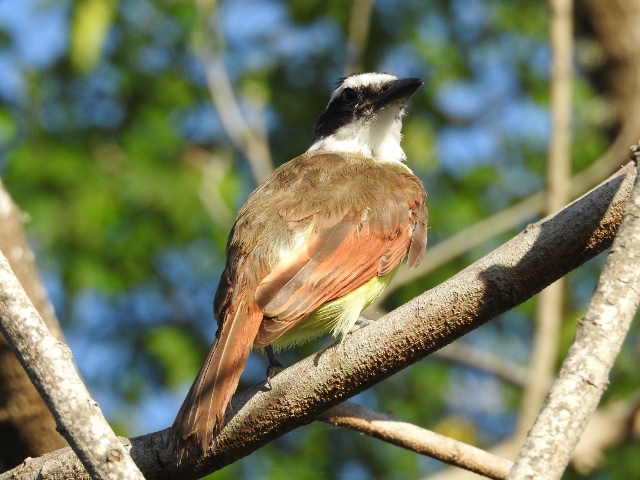by M. Kathy Raines

“Kis-ka DEE! Kis-ka-DEE!”
The great kiskadee, a feisty, strikingly-colored flycatcher, shrieked its name as it swooped through the foliage fringing a boardwalk at Sabal Palm Sanctuary in Brownsville.
Though chirps and calls often baffle me as I seek out flitting songsters, I never fail to recognize the brash call of this aptly-named bird—the last syllable of which ends in an unmistakable whine, rather like the sound of a cat or a squeaky toy. Its name originally comes from the French “Qu’est-ce qu’il dit?”, meaning, “What did he say?”
The genus name of the great kiskadee (Pitangus sulphuratus) originates with the Brazilian Tupi word “pitangua”, for “flycatcher”. “Sulphuratus” describes its brilliant yellow color. The bird’s order, Passerformes, denotes a perching bird, one with three forward and one backward-pointing toes. It is the largest in the family Tyrannidae, for tyrant flycatchers. Early field guides called it the kiskadee flycatcher.
The great kiskadee, a large, thick-billed bird, wears a black cap, topped with an often-hidden yellow patch. A bold black patch streaks across its beak on a white head. Its belly is yellow, its wings and tail, reddish brown. The bird’s large eyes may help it home in on prey. Its black mask, like an athlete’s “eye-black”, seems to help it detect insects and fish in sun-dazzled water.
This bird prefers riparian forests (those near water), thorn scrub or woodland edges, but, having a diverse diet, it flourishes in a variety of habitats. And its numbers are growing. Though a somewhat noteworthy find here in the 1970s, I now hear the birds’ unmistakable “Kis-ka-DEE!” most days as they flash through the canopy of my Brownsville neighborhood. They nest in our trees and join the locals at my feeder, especially when I’ve put out fruit. Though once uncommon along our coast, I often see them at the South Padre Island Birding, Nature Center and Alligator Sanctuary.
This tropical bird now nests in Louisiana’s Mississippi Delta and areas around Houston. Great kiskadees live in the Caribbean and extend as far south as central Argentina.
An omnivore, the kiskadee gleans insects and spiders, as well as fruits, from leaves and branches, a process called “snatch-gleaning”. It also seizes insects midair, plunging—much like a kingfisher— into surface water for dragonflies and little fish. In dry areas, it eats small snakes, lizards and mice. One observer witnessed a kiskadee flying with a small mouse, which it repeatedly bashed against a tree—presumably making it palatable—dropping it occasionally, and, with the aid of a partner, snatching it back up.
The kiskadee visits feeders and particularly relishes sweets like bananas and peanut butter. It also eats pet food, scavenges through garbage and sometimes raids other birds’ nests or steals their food.
Great kiskadees are generally monogamous, with couples remaining together throughout the year. In courtship, a bird may lift its head and drop its bill, revealing its fuzzy yellow crown.
Together, both sexes gather nesting material such as grass, Spanish moss, paper, cotton, sticks and feathers, by hovering over it, then plucking it up. Also, they may steal materials from other birds’ nests. Both birds build and wedge a football-shaped nest into a tree fork or cavity, between clusters of bananas, in nesting boxes or a crack in a building, depending upon available resources. Beginning with a cup of soft grasses, kiskadees bolster the sides, topping the nest with an awning-like dome. They enter the tall, bulky affair from the side. Both birds defend their nest ferociously as the female incubates the three-to-five brown speckled white eggs.
The nesters threaten intruders such as grackles, snakes, hawks, and other kiskadees by
stuttering as they give chase or screeching a “Reep!” if their adversary remains still. In the tropics, kiskadees drive away capuchin monkeys and toucans.
Flying close, great kiskadees harass bronzed cowbirds, usually preventing them from parasitizing their nests— laying eggs in their nests, prompting them to raise cowbird chicks—which can devastate less attentive bird populations.
However, despite the kiskadees’ ferocity, the shiny cowbird (Molothrus bonariensis), a tropical bird which may breed in southern Florida, sometimes manages to parasitize kiskadees’ nests. Also, a mere wren, the black-capped donacobius (Donacobius atricapilla) in Amazonian Peru, occasionally raids kiskadees’ nests.
After from 15 to 22 days, hatchlings arrive, weak, nearly naked, and with eyes closed. They appear to fledge in about 15 days. Juveniles, like many young birds, sport a slender yellow line at the inside border of their bills.
Besides its namesake call, the great kiskadee cries “K-reah!” and a raucous “Kayeer kayeer trrrrrr kweer!” at dawn, along with other vocalizations. Kiskadees will fight fiercely both for what is theirs and what is not. One observer witnessed a kiskadee pecking at a pocket gopher’s head. Then, when the tormented creature retreated, the bird took its place, resting upon the rodent’s abandoned mound.
This boisterous, aggressive bird appears to have an innate fear of coral snakes. In one experiment, hand-raised birds, while eagerly pecking at sticks adorned with various patterns, not only shunned, but gave cries of alarm at seeing those painted like coral snakes.

